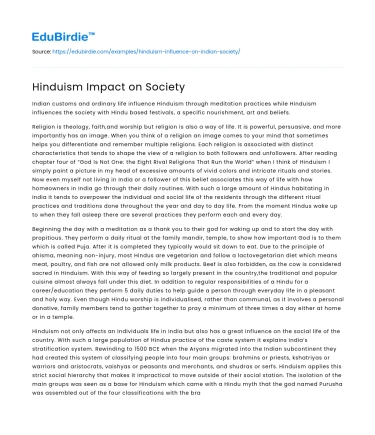Indian customs and ordinary life influence Hinduism through meditation practices while Hinduism influences the society with Hindu based festivals, a specific nourishment, art and beliefs.
Religion is theology, faith,and worship but religion is also a way of life. It is powerful, persuasive, and more importantly has an image. When you think of a religion an image comes to your mind that sometimes helps you differentiate and remember multiple religions. Each religion is associated with distinct characteristics that tends to shape the view of a religion to both followers and unfollowers. After reading chapter four of “God Is Not One: the Eight Rival Religions That Run the World” when I think of Hinduism I simply paint a picture in my head of excessive amounts of vivid colors and intricate rituals and stories. Now even myself not living in India or a follower of this belief associates this way of life with how homeowners in India go through their daily routines. With such a large amount of Hindus habitating in India it tends to overpower the individual and social life of the residents through the different ritual practices and traditions done throughout the year and day to day life. From the moment Hindus wake up to when they fall asleep there are several practices they perform each and every day.
Save your time!
We can take care of your essay
- Proper editing and formatting
- Free revision, title page, and bibliography
- Flexible prices and money-back guarantee
Beginning the day with a meditation as a thank you to their god for waking up and to start the day with propitious. They perform a daily ritual at the family mandir, temple, to show how important God is to them which is called Puja. After it is completed they typically would sit down to eat. Due to the principle of ahisma, meaning non-injury, most Hindus are vegetarian and follow a lactovegetarian diet which means meat, poultry, and fish are not allowed only milk products. Beef is also forbidden, as the cow is considered sacred in Hinduism. With this way of feeding so largely present in the country,the traditional and popular cuisine almost always fall under this diet. In addition to regular responsibilities of a Hindu for a career/education they perform 5 daily duties to help guide a person through everyday life in a pleasant and holy way. Even though Hindu worship is individualised, rather than communal, as it involves a personal donative, family members tend to gather together to pray a minimum of three times a day either at home or in a temple.
Hinduism not only affects an individuals life in India but also has a great influence on the social life of the country. With such a large population of Hindus practice of the caste system it explains India’s stratification system. Rewinding to 1500 BCE when the Aryans migrated into the Indian subcontinent they had created this system of classifying people into four main groups: brahmins or priests, kshatriyas or warriors and aristocrats, vaishyas or peasants and merchants, and shudras or serfs. Hinduism applies this strict social hierarchy that makes it impractical to move outside of their social station. The isolation of the main groups was seen as a base for Hinduism which came with a Hindu myth that the god named Purusha was assembled out of the four classifications with the brahmins or priest being the head and the shudras or serfs as the feet.
The Hinduism religion continues to prosper in modern day India through evolution. It influences the Indian society through everyday life and the community with temples, beliefs, Hindu-inspired festivals, and a definite type of art. Many Indian laws would not exist if it weren’t for Hinduism. For example, the law that bans killing cows because of the deep respect Hindus have of cows. It also is the reason for how poverty is viewed throughout the country. Not only is the customs of Indian life evolving with the influence of Hinduism but Hinduism is evolving from a mixture of Indian customs and traditions.






 Stuck on your essay?
Stuck on your essay?

